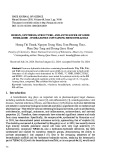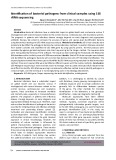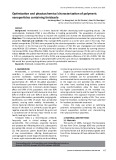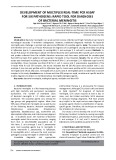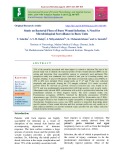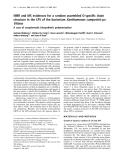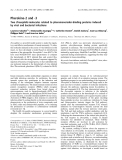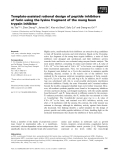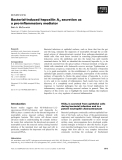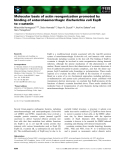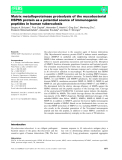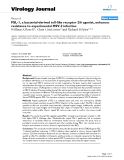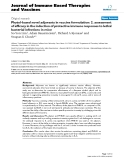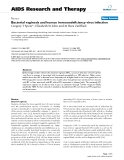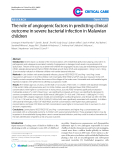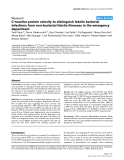
Bacterial infections
-
Design, synthesis, structure, and anticancer of some hydrazide - hydrazones containing benzothiazole
A benzothiazole ring plays an important role in pharmacological target diseases, including metabolic diseases, cancer, anti-inflammatory, neurodegeneration, viral diseases, bacterial infections, fibrosis, and thrombosis. Hydrazone-hydrazide derivatives are present in numerous biological molecules and play a significant role in medicine and pharmacology.
 9p
9p  viaburame
viaburame
 14-03-2025
14-03-2025
 1
1
 1
1
 Download
Download
-
Acne is a common disorder, associated with inflammation of the sebaceous and bacterial hair follicle units and has diverse clinical manifestations. The most commonly mentioned causes and factors associated with the onset of acne in adulthood are hormones, antibiotic-resistant bacteria, and the use of drugs and cosmetics.
 7p
7p  vinara
vinara
 11-01-2025
11-01-2025
 1
1
 1
1
 Download
Download
-
Bacterial infections have a substantial impact on global health and can become serious if misdiagnosed with several diseases related to the central nervous, cardiovascular, and respiratory systems. The prognosis in patients with infectious disease strongly depends on early diagnosis and appropriate antibiotic therapy. We aimed to compare the accuracy of genus and species-level identification bacteria using biochemical testing and 16S rRNA sequence analysis.
 8p
8p  viharuno
viharuno
 03-01-2025
03-01-2025
 3
3
 2
2
 Download
Download
-
Periodontitis is a chronic bacterial infection destroying tooth-supporting tissues. Like metronidazole, tinidazole (TNZ) is also effective in treating periodontitis. This study aimed to formulate and optimize TNZ nanoparticles and evaluate their physicochemical properties.
 9p
9p  viharuno
viharuno
 03-01-2025
03-01-2025
 3
3
 2
2
 Download
Download
-
Bacterial meningitis is an acute central nervous infection with high mortality or permanent neurological sequelae if remained undiagnosed. The present study will therefore aim to set up in-house PCR assays for diagnosis of six pathogens causing the disease including H. influenzae type b, S. pneumoniae, N. meningitidis, S. suis serotype 2, E. coli and S. aureus.
 7p
7p  viuchiha
viuchiha
 03-01-2025
03-01-2025
 4
4
 2
2
 Download
Download
-
75% of the mortality associated with burn injuries is related to infection The aim of the present study was to identify the bacterial profile of burn wound infection (BWI) in our setting and determine their susceptibility pattern to commonly used antibiotics.This prospective study was conducted over a period of one year in a teaching tertiary care hospital, Chennai. A total of 100 patients with burns of total body surface area (TBSA) of 20% to 40% were included. Three wound swabs on 1st , 4 th and 7th day were collected aseptically and processed.
 9p
9p  kequaidan7
kequaidan7
 01-09-2020
01-09-2020
 26
26
 3
3
 Download
Download
-
This topic is researched for two goals: Description of clinical characteristics, subclinical disease Peritonitis infections spontaneously. Results of identification of bacteria and antibiotics on the isolates of bacteria. Evaluation of the results of treatment of peritonitis infection spontaneously in patients with cirrhosis.
 27p
27p  slimzslimz
slimzslimz
 21-12-2019
21-12-2019
 37
37
 8
8
 Download
Download
-
Xanthomonas campestrispv.vitians is a Gram-negative plant-associated bacterium that acts as causative agent of bacterial leaf spot and headrot in lettuce. The lipopolysac-charide of this bacterium is suspected to be an important molecule for adhesion to and infection of the plants. The lipopolysaccharide has been isolated from the phenol phase and the O-specific chain characterized by compositional analysis, high fieldNMRandMALDI-TOFMS.
 9p
9p  research12
research12
 23-04-2013
23-04-2013
 45
45
 2
2
 Download
Download
-
Drosophilais a powerful model system to study the regula-tory and effector mechanisms of innate immunity. To iden-tify molecules induced in the course of viral infection in this insect, we have developed a model based on intrathoracic injection of the picorna-like DrosophilaCvirus(DCV).We have used MALDI-TOF mass spectrometry to compare the hemolymph of DCV infected flies and control flies. By contrast with the strong humoral response triggered by injectionof bacteriaor fungal spores, we have identifiedonly one molecule induced in the hemolymph of virus infected flies....
 10p
10p  tumor12
tumor12
 20-04-2013
20-04-2013
 29
29
 3
3
 Download
Download
-
Highly active, small-molecule furin inhibitors are attractive drug candidates to fend off bacterial exotoxins and viral infection. Based on the 22-residue, active Lys fragment of the mung bean trypsin inhibitor, a series of furin inhibitors were designed and synthesized, and their inhibitory activity towards furin and kexin was evaluated using enzyme kinetic analysis.
 8p
8p  inspiron33
inspiron33
 25-03-2013
25-03-2013
 49
49
 5
5
 Download
Download
-
Bacterial infections at epithelial surfaces, such as those that line the gut and the lung, stimulate the migration of neutrophils through the co-ordi-nated actions of chemoattractants secreted from pathogen-stimulated epi-thelial cells. One such factor involved in attracting polymorphonuclear leukocytes across the epithelium and into the lumen has until recently remained elusive.
 6p
6p  galaxyss3
galaxyss3
 21-03-2013
21-03-2013
 42
42
 3
3
 Download
Download
-
The incidence of mixed viral⁄bacterial infections has increased recently because of the dramatic increase in antibiotic-resistant strains, the emer-gence of new pathogens, and the resurgence of old ones. Despite the relat-ively well-known role of viruses in enhancing bacterial infections, the impact of bacterial infections on viral infections remains unknown.
 14p
14p  galaxyss3
galaxyss3
 19-03-2013
19-03-2013
 39
39
 3
3
 Download
Download
-
Type III secretion systems of Gram-negative pathogenic bacteria allow the injection of effector proteins into the cytosol of host eukaryotic cells. Cros-sing of the eukaryotic plasma membrane is facilitated by a translocon, an oligomeric structure made up of two bacterial proteins inserted into the host membrane during infection.
 10p
10p  galaxyss3
galaxyss3
 19-03-2013
19-03-2013
 42
42
 4
4
 Download
Download
-
EspB is a multifunctional protein associated with the type III secretion system of enterohaemorrhagic Escherichia coli, and interacts with various biomolecules includinga-catenin in the host cell. The binding of EspB to a-catenin is thought be involved in actin reorganization during bacterial infection, although the precise mechanism of this phenomenon is still unclear.
 8p
8p  vinaphone15
vinaphone15
 28-02-2013
28-02-2013
 35
35
 4
4
 Download
Download
-
Mycobacterium tuberculosisis the causative agent of human tuberculosis (TB). Mycobacterial secretory protein ESAT-6 induces matrix metallopro-teinase (MMP)-9 in epithelial cells neighboring infected macrophages. MMP-9 then enhances recruitment of uninfected macrophages, which con-tribute to nascent granuloma maturation and bacterial growth.
 10p
10p  cosis54
cosis54
 09-12-2012
09-12-2012
 41
41
 3
3
 Download
Download
-
Tuyển tập báo cáo các nghiên cứu khoa học quốc tế ngành y học dành cho các bạn tham khảo đề tài: FSL-1, a bacterial-derived toll-like receptor 2/6 agonist, enhances resistance to experimental HSV-2 infection
 11p
11p  dauphong4
dauphong4
 24-12-2011
24-12-2011
 46
46
 5
5
 Download
Download
-
Tuyển tập báo cáo các nghiên cứu khoa học quốc tế ngành y học dành cho các bạn tham khảo đề tài: Phytol-based novel adjuvants in vaccine formulation: 2. assessment of efficacy in the induction of protective immune responses to lethal bacterial infections in mice...
 10p
10p  thulanh28
thulanh28
 14-12-2011
14-12-2011
 62
62
 3
3
 Download
Download
-
Tuyển tập các báo cáo nghiên cứu về y học được đăng trên tạp chí y học Wertheim cung cấp cho các bạn kiến thức về ngành y đề tài: Bacterial vaginosis and human immunodeficiency virus infection...
 5p
5p  toshiba21
toshiba21
 18-11-2011
18-11-2011
 45
45
 3
3
 Download
Download
-
Tuyển tập các báo cáo nghiên cứu về y học được đăng trên tạp chí y học quốc tế cung cấp cho các bạn kiến thức về ngành y đề tài: The role of angiogenic factors in predicting clinical outcome in severe bacterial infection in Malawian children...
 11p
11p  coxanh_6
coxanh_6
 30-10-2011
30-10-2011
 37
37
 3
3
 Download
Download
-
Tuyển tập các báo cáo nghiên cứu về y học được đăng trên tạp chí y học Critical Care giúp cho các bạn có thêm kiến thức về ngành y học đề tài: C-reactive protein velocity to distinguish febrile bacterial infections from non-bacterial febrile illnesses in the emergency department...
 8p
8p  thulanh18
thulanh18
 28-10-2011
28-10-2011
 50
50
 3
3
 Download
Download
CHỦ ĐỀ BẠN MUỐN TÌM








